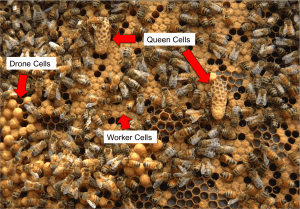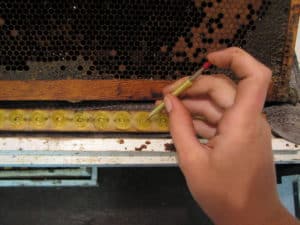
Thousands of queens are raised and sold around the country. But how does one get their bees to raise all these extra queens? The secret lies within manipulating the bees own biology (as does most of beekeeping). There are two types of eggs in the colony: unfertilized and fertilized. The unfertilized eggs will become drones and the fertilized eggs will become female bees, either workers or queens. A bee must be born a queen, but there is no difference in genetics. She becomes either a worker or queen depending on how she is raised and what she is fed. Bees destined to become workers develop in the same type of horizontal cells that honey or pollen is stored in. Future queens develop in cells that hang vertically from the comb (see picture). The position and size of the cell gives nurse bees cues of what diet to feed the developing larva, with the future queens getting a higher proportion of a food secreted by the nurse bees we call “royal jelly.” Understanding this is the key.

Since it is the cell that make a queen a queen, and not genetics, we can take advantage of this by removing larvae laid in worker cells and transferring them into queen cells. This process is called “grafting.” You can literally scoop up a larva and put it into an artificial queen cell (either made of beeswax or royal jelly) and the bees will raise you a queen. The artificial queen cell cups are made of either beeswax or plastic. Once you have all your larvae grafted, you put them in a colony that “thinks” they are queen-less and the bees will raise your properly grafted larvae into queens.
It gets quite a bit more complicated to actually produce queens to sell (as one of the queens producers says: anyone can raise a queen, but it takes lots of planning and hard work to get 1,000 queens ready on a specific date), but the concepts are the same.
Raising queens is my favorite part of beekeeping.
